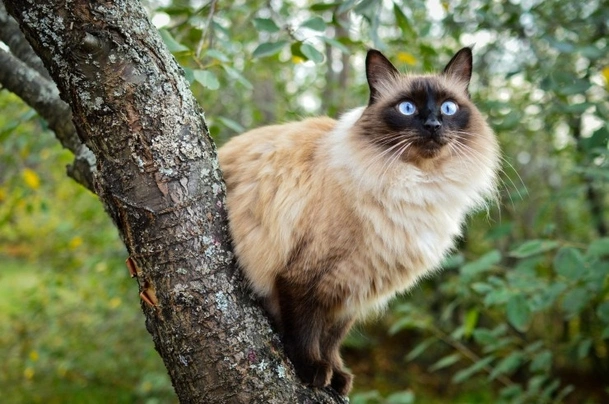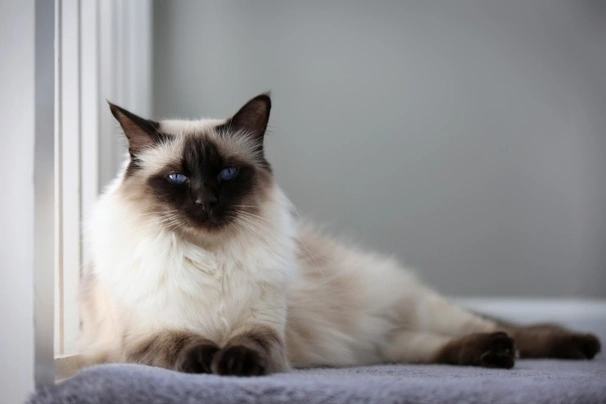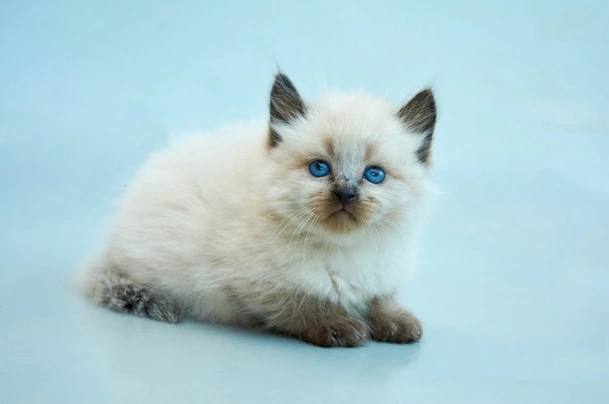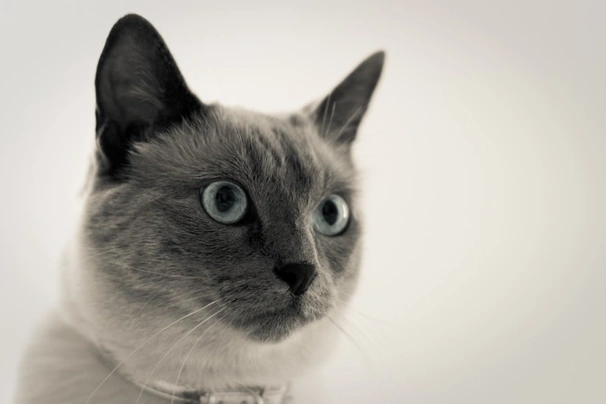Pets
Pets for studWanted petsBreedersAccessories & services
Knowledge hub
Support
Support & safety portalBalinese
Introduction of the Balinese
The Balinese is an extremely graceful cat that looks very similar to a Siamese with the difference being they boast having long fine and silky coats. They are known to be very talkative and love nothing more than chatting away to their owners which is just another of their endearing characteristics and why over the years the Balinese has become an extremely popular choice as a family pet that’s known to get on well with children and other pets.
History of the Balinese
Balinese cats were first developed in the United States during the forties thanks to the fact that many long-haired kittens were born in litters of pedigree Siamese cats. Breeders decided to continue breeding long-haired cats which they did by careful selective breeding so the new breed retained the same traits seen in Siamese cats. As such no other breed was used in a breeding programme to ensure that the Balinese only had Siamese and Balinese cats in their bloodlines.
In 1928 a long-haired Siamese was registered with the Cat Fanciers Association (CFA) but it was not until after the Second World War that people began to take a real interest in breeding long-haired Siamese cats. Three American breeders in particular were instrumental in developing the Balinese and they did so by breeding from two long-haired Siamese cats. The kittens this pairing produced all boasted having long silky coats.
The breed was given their name "Balinese" because other breeders objected to these new long-haired cats being called Siamese. It was not until the early sixties when Balinese cats were exhibited at New York's Empire Cat Show that the breed was recognised by cat associations in the States. Nine years later the breed was granted championship status by the CFA. The Balinese first appeared in the UK during the early seventies and the breed was eventually given full recognition by the GCCF in the eighties. From then on these elegant graceful cats have gained a huge fan base the world over thanks to their charming looks kind natures and the fact they make such wonderful family pets.
Because the gene pool is still quite limited breeders are encouraged to widen it by using well-bred Siamese cats in their breeding programmes. However careful and selective breeding is essential to ensure the Balinese remains a healthy breed. Originally there were only four recognised colours in the breed but over time this has increased to incorporate quite a few more.
Appearance of the Balinese
The Balinese is a very elegant fine boned cat and one that moves very gracefully. They have fine medium to long silky hair but no undercoat which in short means their coats are less likely to tangle and matt. They are well balanced cats that boast having incredibly blue eyes that always have an alert keen and kind expression in them.
The Balinese has a long nicely proportioned head with a good width between their ears and which narrows evenly to a fine muzzle. When seen in profile their muzzle appears straight. They have a strong chin and nice level bite. Ears are on the large size being wider at the base rather wedge-shaped with some cats having tufted ears. Their eyes are nicely oriental in shape with a good width between them and slanting towards a cat's nose. They are a brilliant blue colour and the darker the blue the better. They have medium sized graceful and lithe bodies with slim legs with their back ones being a little higher than their front legs. Feet are oval shaped and small. Tails are plumed long being wider at the base but tapering to the tip.
When it comes to their points their mask ears legs feet and tails boast having a clearly defined colour that contrasts well with their body colour. A mature cat's mask is connected by tracings to their ears whereas in kittens it does not. This only develops as cats mature. The colour of a cat's tail might be a little lighter in colour because the hair on it is longer and therefore dilutes the actual colour.
The Balinese has a medium to long coat that consists of fine and silky hair without any undercoat. As such the hair lies close to a cat's body. The hair around a cat’s chin neck and tail stands out a little and may form a frill which is natural and acceptable although no frill is preferred under the GCCF breed standard. The Balinese does not usually grow their full coat until they are mature cats. The accepted breed colours are as follows:
- Seal Point
- Blue Point
- Chocolate Point
- Lilac Point
- Red Point
- Cream Point
- Apricot Point
- Caramel Point
- Tortie Point
- Seal Tortie Point
- Blue Tortie Point
- Chocolate Tortie Point
- Lilac Tortie Point
- Caramel Tortie Point
- Tabby Point
- Seal Tabby Point
- Blue Tabby Point
- Chocolate Tabby Point
- Lilac Tabby Point
- Red Tabby Point
- Cream Tabby Point
- Caramel Tabby Point
- Apricot Tabby Point
- Tortie Tabby Point
- Seal Tortie Tabby Point
- Blue Tortie Tabby Point
- Chocolate Tortie Tabby Point
- Lilac Tortie Tabby Point
- Caramel Tortie Tabby Point
Temperament of the Balinese
The Balinese is known to be a very loving playful and inquisitive cat. They adore being given lots of attention and can be extremely "chatty". They are also very energetic which means they need to be kept busy. They are thought to be one of the most intelligent cats on the planet and love nothing more than being involved in everything that goes on in their environment. Much like the Siamese the Balinese has sense of humour with the added bonus being they get on well with children which is just another reason why they have become such popular family pets.
They are known to be very sensitive to an owner's mood and will stay close to anyone who is feeling down. They can be a little independent at times but they love playing interactive games like fetch. They are the ideal choice for people who prefer to have an indoor pet but only as long as they are given lots of things to keep them busy and places to hide when they want too. This includes creating "high" places for a Balinese to climb up which is another thing they love to do so they can watch the world below them.
Intelligence / Trainability of the Balinese
The Balinese is known to be one of the most intelligent cats around. They are quick to learn new things which includes playing interactive games like fetch. They also boast a ton of energy and need to be given lots of things to do especially when they are left on their own and kept as indoor pets. Like many other cats the Balinese loves to get up high so they can look down on the world below and will happily climb up curtains if they don't have anything else to climb up. As such it's always a good idea to build a few safe platforms for them which they can use. It's also a good idea to invest in good quality scratching posts and ideally these need to be placed in different areas around the home that a cat likes to spend time in during the day.
Children and other
The Balinese is known to be very good around children and other pets. However younger children need to be taught how to handle and behave around cats to avoid being scratched. They also get on well with dogs they have grown up with but care should be taken when introducing a Balinese to a dog they don't already know just in case the dog does not get on with their feline counterparts. Balinese are incredibly social by nature and have been known to get on with some smaller animals but it's always wiser to keep a close eye on any cat when they are around smaller pets just in case.
Health of the Balinese
The average life expectancy of a Balinese is between 18 and 22 years when properly cared for and fed an appropriate good quality diet to suit their ages. The breed is thought to suffer from the same inherited health issues as the Siamese and this includes the following disorder:
- Progressive retinal atrophy (PRA) – breeders should have stud cats eye tested
Caring for the Balinese
The Balinese needs to be groomed on a regular basis to make sure their coats and skin are kept in top condition. They also need to be given regular daily exercise in the form of playing interactive games with them which helps ensure they remain fit and healthy. On top of this they need to be fed good quality food that meets all their nutritional needs throughout their lives which is especially the case in kittens and older cats.
Grooming of the Balinese
The Balinese boasts having medium to long close lying single coat and as such they are low maintenance on the grooming front. A weekly brush leather is all it takes to keep their coats in good condition and because they don't have an undercoat there's less chance of tangles and knots forming. Like other breeds they tend to shed the most in the Spring and then again in the Autumn when more frequent brushing is usually necessary to keep on top of things.
It's also important to check a cat's ears on a regular basis and to clean them when necessary. If too much wax is allowed to build up it can lead to a painful infection which can be hard to clear up. In short prevention is often easier than cure with ear infections. Cats often suffer from ear mites which can be a real problem which is why it's so important to check their ears on a regular basis.
Exercise of the Balinese
The Balinese enjoys being able to explore the great outdoors however care has to be taken if you live in a built up area or near a busy road. With this said cats that are kept as indoor pets need to be given lots of things to do and places to hide when they want to bearing in mind that the Balinese loves to climb up high so they can look down on the world below. They also need to have lots of places they can snuggle up for a snooze when the mood takes them because if there’s one thing cats love doing it's napping a lot during the day.
Balinese are energetic cats and are very playful. They love playing "fetch" and chasing around after toys which is why they make such wonderful family pets and companions. They adore all the attention they get but are more likely to play in short bursts before curling up in on a sunny window ledge to take a nap.
Feeding of the Balinese
If you get a Balinese kitten from a breeder they would give you a feeding schedule and it's important to stick to the same routine feeding the same kitten food to avoid any tummy upsets. You can change a kitten's diet but this needs to be done very gradually always making sure they don't develop any digestive upsets and if they do it's best to put them back on their original diet and to discuss things with the vet before attempting to change it again.
Older cats are not known to be fussy eaters but this does not mean they can be given a lower quality diet. It's best to feed a mature cat several times a day making sure it's good quality food that meets all their nutritional requirements which is especially important as cats get older. It's also essential to keep an eye on a cat's weight because if they start to put on too much it can have a serious impact on their overall health and wellbeing. As such it's a good idea to keep special "treats" to a minimum.
Balinese price
If you are looking to buy a Balinese you would need to pay upwards of £300 for a well-bred pedigree kitten. You would also need to register your interest with breeders and agree to being put on a waiting list because very few kittens are bred every year. The cost of insuring a male 3-year-old Balinese in northern England would be £16.27 a month for basic cover but for a lifetime policy this would set you back £28.65 a month (quote as of April 2018). When insurance companies calculate a pet's premium they factor in several things which includes where you live in the UK a cat's age and whether they have been neutered or spayed among other things.
When it comes to food costs you need to buy the best quality food whether wet or dry making sure it suits the different stages of a cat’s life. This would set you back between £10 - £15 a month. On top of this you need to factor in veterinary costs if you want to share your home with a Balinese and this includes their initial vaccinations their annual boosters the cost of neutering or spaying a cat when the time is right and their yearly health checks all of which quickly adds up to over £500 a year.
As a rough guide the average cost to keep and care for a Balinese would be between £30 to £50 a month depending on the level of insurance cover you opt to buy for your cat but this does not include the initial cost of buying a well-bred kitten.



